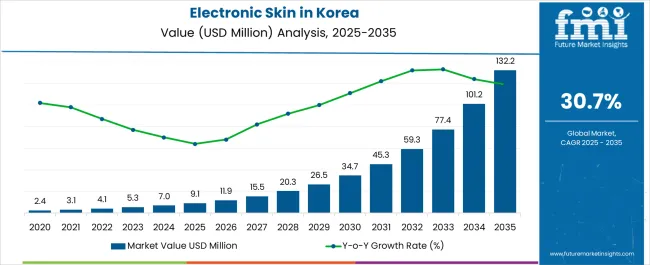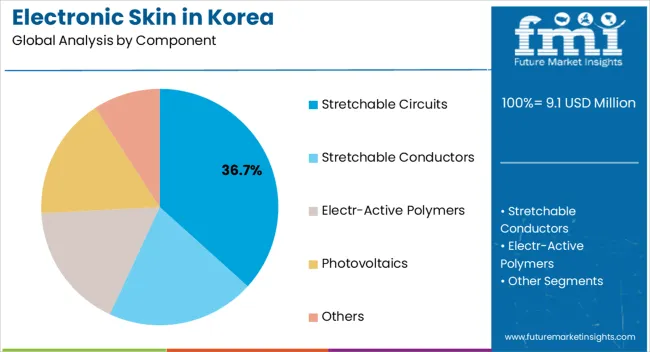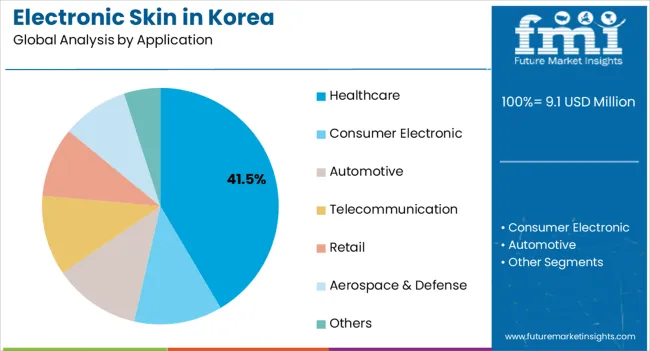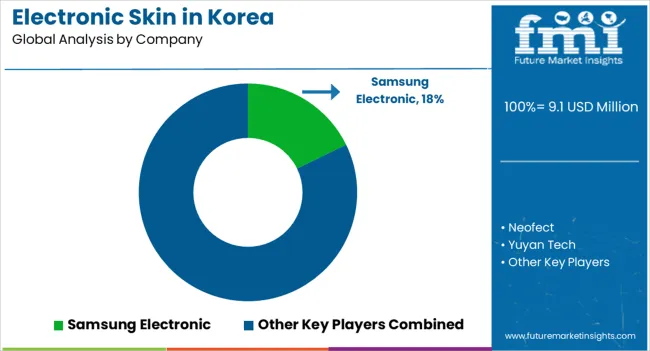The Industry Analysis of Electronic Skin in Korea is estimated to be valued at USD 9.1 million in 2025 and is projected to reach USD 132.2 million by 2035, registering a compound annual growth rate (CAGR) of 30.7% over the forecast period.

| Metric | Value |
|---|---|
| Industry Analysis of Electronic Skin in Korea Estimated Value in (2025 E) | USD 9.1 million |
| Industry Analysis of Electronic Skin in Korea Forecast Value in (2035 F) | USD 132.2 million |
| Forecast CAGR (2025 to 2035) | 30.7% |
The electronic skin market in Korea is witnessing rapid development. Rising demand for wearable healthcare devices, advancements in flexible electronics, and increased research investment are driving market expansion. Current market dynamics are characterized by integration of stretchable and sensitive sensor technologies, high adoption in medical monitoring, and support from government initiatives promoting digital health solutions.
Growing awareness of personalized healthcare and non-invasive monitoring is further enhancing uptake. The future outlook is shaped by technological innovations in materials, miniaturization, and connectivity, which are enabling multifunctional applications and improved user experience. Growth rationale is underpinned by the critical role of electronic skin in healthcare monitoring, rehabilitation, and human-machine interfacing.
Continuous improvement in component performance, scalability of manufacturing processes, and strategic collaboration between research institutes and industry players are expected to sustain market growth Expansion into emerging application areas and the adoption of smart wearable solutions are likely to reinforce Korea’s position as a leading market for electronic skin technologies.

The stretchable circuits segment, holding 36.7% of the component category, has maintained a leading position due to its essential function in enabling flexibility, conformability, and reliable electrical performance under dynamic conditions. Adoption has been driven by integration into healthcare monitoring devices, robotics, and wearable electronics.
High material performance, including elasticity, conductivity, and durability, has supported the segment’s market share. Manufacturing improvements and precision fabrication techniques have enhanced quality consistency and operational reliability.
Strategic collaborations between component developers and device manufacturers have facilitated wider commercialization Continued research in nanomaterials, conductive polymers, and scalable production methods is expected to expand the applicability of stretchable circuits, sustain market leadership, and reinforce the segment’s contribution to the overall electronic skin market in Korea.

The healthcare application segment, representing 41.5% of the application category, has remained dominant due to the growing focus on continuous patient monitoring, non-invasive diagnostics, and personalized care. Adoption has been supported by integration into wearable devices for vital sign tracking, rehabilitation, and chronic disease management.
Regulatory support, hospital adoption, and increasing consumer awareness have strengthened market uptake. Technological advancements in sensor sensitivity, data accuracy, and wireless connectivity have improved clinical relevance and user experience.
Expansion of healthcare infrastructure and digital health initiatives are expected to sustain the segment’s market share The healthcare application continues to serve as a key driver of demand, supporting innovation, commercialization, and the broader adoption of electronic skin technologies in Korea.
Stretchable circuits are preferred in the Korea e-skin sector largely because of their exceptional capacity to adapt to the flexible and dynamic properties of human skin. This feature is essential for developing wearable electronic devices that can easily conform to the curves of the body. It enables a more inconspicuous and natural user experience.The combination of stretchy circuits with a wide range of sensors, including pressure, temperature, and biofeedback sensors, primarily fuels demand for e-skin. This dynamic adaptability opens up a wide range of applications, encompassing important industries, including robotics, virtual reality, and prosthetics.
In order to endure the mechanical strains brought on by movement and distortion, stretchy circuits can incorporate specific materials and components. Traditional, inflexible circuits are inadequate for this task since they can be burdensome and vulnerable to breakage. As a result, the demand for stretchable electronic skin circuits is increasing rapidly.
Since e-skin offers a novel method of patient health monitoring, demand for it in Korea’s healthcare sector is rising significantly. Vital indicators, including temperature, heart rate, and blood pressure, can be comfortably and continuously monitored because of their flexible, thin, and lightweight design. Healthcare personnel can immediately intervene and modify patient treatment owing to this real-time data, which improves results.
| Electronic Skin in Korea based on Application | Healthcare |
|---|---|
| Value CAGR from 2025 to 2035 | 32.4% |
The growing demand for e-skin is being driven by Korea's aging population. E-skin offers a non-invasive and practical option for the increasing number of older people who require ongoing healthcare monitoring. Both patients and caregivers find it to be a desirable alternative due to its ease of integration into everyday life.
Both healthcare professionals and researchers are interested in e-skin technology because of its revolutionary character. Beyond vital sign monitoring, e-skin has potential uses in wound care, artificial limbs, and rehabilitation. This adaptability has aroused interest in the healthcare sector and increased demand.

A dynamic interplay between research institutes, start-ups, and established firms defines the competitive landscape for electronic skin technology in Korea. Research institutions like KAIST and Seoul National University have been at the forefront, utilizing their knowledge of flexible electronics and materials science.
Corporate research divisions have also been crucial in promoting innovation in this field, notably those of top technological conglomerates. This ecosystem supports a dynamic environment for electronic skin development in Korea by supporting partnerships, multidisciplinary methods, and a culture of ongoing inquiry.
Recent Developments
| Attribute | Details |
|---|---|
| Estimated Valuation (2025) | USD 9.1 million |
| Projected Valuation (2035) | USD 132.2 million |
| Anticipated CAGR (2025 to 2035) | 30.7% CAGR |
| Historical Analysis of Demand for Electronic Skin in Korea | 2020 to 2025 |
| Demand Forecast for Electronic Skin in Korea | 2025 to 2035 |
| Quantitative Units | Revenue in USD million and CAGR from 2025 to 2035 |
| Report Coverage | Revenue Forecast, Company Ranking, Competitive Landscape, Growth Factors, Trends and Pricing Analysis |
| Key Companies Profiled | Neofect; Yuyan Tech; Amorepacific; LG Electronic; Samsung Electronic; MC10 Korea; Laxcen; Hexoskin; Amkiri; MetaSkin |
The global industry analysis of electronic skin in Korea is estimated to be valued at USD 9.1 million in 2025.
The market size for the industry analysis of electronic skin in Korea is projected to reach USD 132.2 million by 2035.
The industry analysis of electronic skin in Korea is expected to grow at a 30.7% CAGR between 2025 and 2035.
The key product types in industry analysis of electronic skin in Korea are stretchable circuits, stretchable conductors, electr-active polymers, photovoltaics and others.
In terms of application, healthcare segment to command 41.5% share in the industry analysis of electronic skin in Korea in 2025.






Full Research Suite comprises of:
Market outlook & trends analysis
Interviews & case studies
Strategic recommendations
Vendor profiles & capabilities analysis
5-year forecasts
8 regions and 60+ country-level data splits
Market segment data splits
12 months of continuous data updates
DELIVERED AS:
PDF EXCEL ONLINE
Industry 4.0 Market
Industry Analysis Non-commercial Acrylic Paint in the United States Size and Share Forecast Outlook 2025 to 2035
Industry Analysis of Outbound Tourism in Germany Size and Share Forecast Outlook 2025 to 2035
Industry Analysis of Syringe and Needle in GCC Size and Share Forecast Outlook 2025 to 2035
Industry Analysis of Medical Device Packaging in Southeast Asia Size and Share Forecast Outlook 2025 to 2035
Industry Analysis of Paper Bag in North America Size and Share Forecast Outlook 2025 to 2035
Industry Analysis of Lidding Film in the United States Size and Share Forecast Outlook 2025 to 2035
Industry Analysis of Last-mile Delivery Software in Japan Size and Share Forecast Outlook 2025 to 2035
Industry Analysis of Automotive Lightweight Body Panel in the United States Size and Share Forecast Outlook 2025 to 2035
Europe Second-hand Apparel Market Growth – Trends & Forecast 2024-2034
Industry Analysis of Electronic Skin in Japan Size and Share Forecast Outlook 2025 to 2035
Industry Analysis of Electronic Skin in Western Europe Size and Share Forecast Outlook 2025 to 2035
DOAS Industry Analysis in the United States Forecast and Outlook 2025 to 2035
FIBC Industry Analysis in Japan Size and Share Forecast Outlook 2025 to 2035
Pectin Industry Analysis in Japan Size and Share Forecast Outlook 2025 to 2035
Western Europe Pectin Market Analysis by Product Type, Application, and Country Through 2035
Mezcal Industry Analysis in Japan - Consumer Demand & Industry Trends in 2025
Mezcal Industry Analysis in Western Europe Report – Growth, Demand & Forecast 2025 to 2035
Asia Pacific Dental Market Analysis – Growth, Trends & Forecast 2024-2034
Mezcal Industry Analysis in Korea – Trends, Demand & Industry Growth

Thank you!
You will receive an email from our Business Development Manager. Please be sure to check your SPAM/JUNK folder too.
Chat With
MaRIA